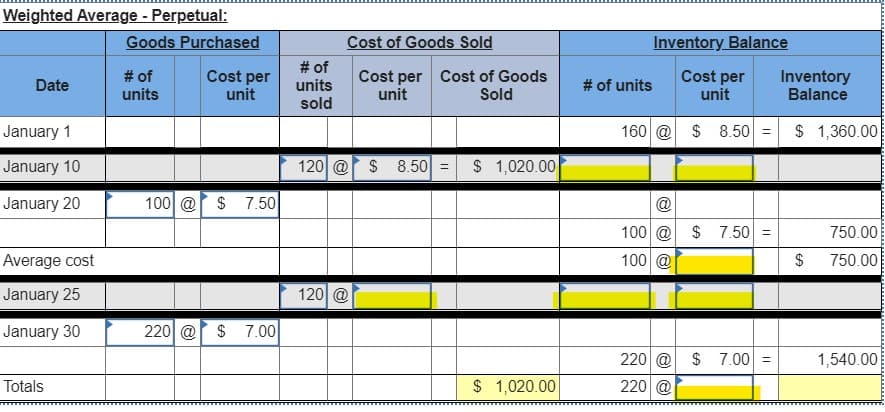Laker Company reported the following January purchases and sales data for its only product. Date Activities Units Acquired at Cost Units sold at Retail Jan. 1 Beginning inventory 160 units @ $ 8.50 = $ 1,360 Jan. 10 Sales 120 units @ $ 17.50 Jan. 20 Purchase 100 units @ $ 7.50 = 750 Jan. 25 Sales 120 units @ $ 17.50 Jan. 30 Purchase 220 units @ $ 7.00 = 1,540 Totals 480 units $ 3,650 240 units
Laker Company reported the following January purchases and sales data for its only product. Date Activities Units Acquired at Cost Units sold at Retail Jan. 1 Beginning inventory 160 units @ $ 8.50 = $ 1,360 Jan. 10 Sales 120 units @ $ 17.50 Jan. 20 Purchase 100 units @ $ 7.50 = 750 Jan. 25 Sales 120 units @ $ 17.50 Jan. 30 Purchase 220 units @ $ 7.00 = 1,540 Totals 480 units $ 3,650 240 units
Chapter10: Inventory
Section: Chapter Questions
Problem 7PA: Use the weighted-average (AVG) cost allocation method, with perpetual inventory updating, to...
Related questions
Topic Video
Question
Laker Company reported the following January purchases and sales data for its only product.
| Date | Activities | Units Acquired at Cost | Units sold at Retail | |||||||||||||||
| Jan. | 1 | Beginning inventory | 160 | units | @ | $ | 8.50 | = | $ | 1,360 | ||||||||
| Jan. | 10 | Sales | 120 | units | @ | $ | 17.50 | |||||||||||
| Jan. | 20 | Purchase | 100 | units | @ | $ | 7.50 | = | 750 | |||||||||
| Jan. | 25 | Sales | 120 | units | @ | $ | 17.50 | |||||||||||
| Jan. | 30 | Purchase | 220 | units | @ | $ | 7.00 | = | 1,540 | |||||||||
| Totals | 480 | units | $ | 3,650 | 240 | units | ||||||||||||
The Company uses a perpetual inventory system. For specific identification, ending inventory consists of 240 units, where 220 are from the January 30 purchase, 5 are from the January 20 purchase, and 15 are from beginning inventory.
Required:
1. Determine the cost assigned to ending inventory and to cost of goods sold using weighted average.
2. Determine the cost assigned to ending inventory and to cost of goods sold using FIFO.
3. Determine the cost assigned to ending inventory and to cost of goods sold using LIFO.
(only need the ones in yellow)

Transcribed Image Text:Weighted Average - Perpetual:
Goods Purchased
Cost of Goods Sold
Inventory Balance
# of
units
Cost per
unit
# of
units
sold
Cost per Cost of Goods
unit
Cost per
unit
Inventory
Balance
Date
# of units
Sold
January 1
160 @ $ 8.50 =
$ 1,360.00
January 10
120 @ $ 8.50 =
$ 1,020.00
January 20
100 @ $ 7.50
@
100 @ $ 7.50 =
750.00
Average cost
100 @
750.00
January 25
120 @
January 30
220 @ $ 7.00
220 @ $ 7.00 =
1,540.00
Totals
$ 1,020.00
220 @
%24

Transcribed Image Text:Perpetual FIFO:
Perpetual LIFO:
Goods Purchased
Cost of Goods Sold
Inventory Balance
Cost of Goods Sold
Cost per Cost of Goods
Sold
Goods Purchased
Inventory Balance
Cost per
unit
# of
# of units
# of
units
Cost per
unit
# of units
sold
Cost per
unit
Cost per
unit
Cost per
unit
Inventory
Balance
Cost of Goods
Inventory
Balance
Date
# of units
Date
# of units
Sold
units
sold
unit
January 1
160 @
$ 8.50 =
$ 1,360.00
January 1
160 @
$ 8.50 =
$ 1,360.00
January 10
January 10
January 20
January 20
January 25
January 25
January 30
January 30
Totals
Totals
Expert Solution
This question has been solved!
Explore an expertly crafted, step-by-step solution for a thorough understanding of key concepts.
This is a popular solution!
Trending now
This is a popular solution!
Step by step
Solved in 3 steps

Knowledge Booster
Learn more about
Need a deep-dive on the concept behind this application? Look no further. Learn more about this topic, accounting and related others by exploring similar questions and additional content below.Recommended textbooks for you

Principles of Accounting Volume 1
Accounting
ISBN:
9781947172685
Author:
OpenStax
Publisher:
OpenStax College

Cornerstones of Financial Accounting
Accounting
ISBN:
9781337690881
Author:
Jay Rich, Jeff Jones
Publisher:
Cengage Learning

Intermediate Accounting: Reporting And Analysis
Accounting
ISBN:
9781337788281
Author:
James M. Wahlen, Jefferson P. Jones, Donald Pagach
Publisher:
Cengage Learning

Principles of Accounting Volume 1
Accounting
ISBN:
9781947172685
Author:
OpenStax
Publisher:
OpenStax College

Cornerstones of Financial Accounting
Accounting
ISBN:
9781337690881
Author:
Jay Rich, Jeff Jones
Publisher:
Cengage Learning

Intermediate Accounting: Reporting And Analysis
Accounting
ISBN:
9781337788281
Author:
James M. Wahlen, Jefferson P. Jones, Donald Pagach
Publisher:
Cengage Learning


Cornerstones of Cost Management (Cornerstones Ser…
Accounting
ISBN:
9781305970663
Author:
Don R. Hansen, Maryanne M. Mowen
Publisher:
Cengage Learning